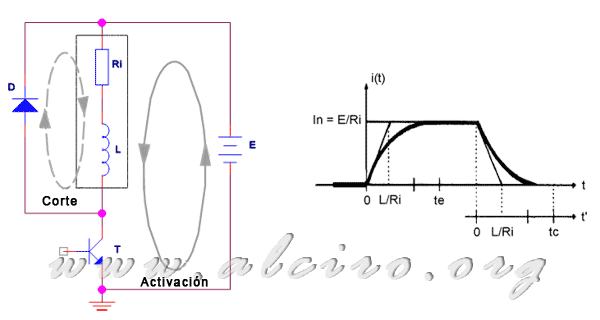4.3.2. Constant voltage feeding
Constant voltage feeding a voltage is applied directly to the wound. The value of this depends on the internal resistance of the winding to obtain the nominal value of intensity. So that V = r i * I n.

Figure 4.27. Unipolar control powered by tessión costante.
Figure 4.27. shows a unipolar control of a motor winding. In this exciting current flows from the power source E through the winding, when the transistor T is driving. The speed with which the intensity evolves towards its nominal value depends on the internal characteristics of the winding. These are set by the time constant L / R. The response is inversely proportional to resistance and inductance. Initially interested in the internal resistance of motor winding is great, but having a high internal resistance causes large power losses in it, and therefore the corresponding heating of the motor, so interested that it is the smallest possible. At this point the only factor to determine is the inductance, of interest to be small to provide a transition of power as quickly as possible. When the switch T is blocked, the current flow is cut off from the power source E, but this, which flows through the winding is closed on the suppression diode. Just as in driving, the constant for the power failure will depend on the characteristics of the coil (L / R i). If the nominal current for the winding is E / R i, and the time constant is L / R i, the conduction current through the coil changes according to the expression.
}\ =\ \frac{E}{R_i}*\left( 1-e^{-\frac{t}{L/R_i}} \right)) (4.3)
(4.3)
for cutting.
}\ =\ \frac{E}{R_i}*\left( 1-e^{-\frac{t'}{L/R_i}} \right)) (4.4)
(4.4)
The establishment or power cut by the winding is determined by the times t e c t respectively. These are considered when the current has acquired 95% of its nominal value, hence the settling time and cut are:
 (4.5)
(4.5)
From the dynamic point of view, a hybrid stepper motor one step for each change of current occurs in one of its windings, so that a complete sequence, provides four steps. The speed with which the current changes direction in the windings (exponentially) depends on the inductance, winding resistance and the applied voltage.

Figure 4.28. Waveforms of current through the coil. (A) For a list of steps down, (b) For a list of high steps.
Figure 4.28. (A) shows that at low speeds the way, the current through the coil reaches its nominal value before the reversal occurs. However, if the investment of the winding wire is made faster, more high frequency steps, the current does not have time to reach its nominal value, due to limited development time and cut you and tc (Figure 4.28. (b)). Consequently, the power and torque delivered by the motor decreases with increasing the ratio of steps.







